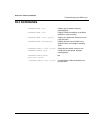
HiSpeed Switch Troubleshooting Guide
10-2
US7070447-001, Rev 01
Draft Level—Hitachi Confidential
Other IP-related Services
The HiSpeed switch supports the following IP-related functions:
❒
Address Resolution Protocol (ARP)
Used to resolve an IP to MAC address allowing devices to
communicate at the Data Link layer. The HiSpeed switch maintains an
ARP table of IP to MAC address mappings.
❒
Internet Control Message Protocol (ICMP)
Provides a mechanism allowing a device to report an error back to the
original source. Ping packets which employ ICMP, are used to
determine whether a device is reachable across the network.
❒
TCP (Transmission Control Protocol)
Used by applications requiring a reliable transport mechanism for
communicating between devices across the network. Examples of
network applications using TCP are: Telnet, FTP, SMTP.
❒
UDP (User Datagram Protocol)
Used by applications that do not require a reliable transport mechanism
for communicating between devices across the network. Examples of
network applications using UDP are: DNS, TFTP, SNMP.
RIP (Routin
g
Information Protocol)
The HiSpeed switch uses RIP, version 1, to route IP packets across VLANs. RIP,
a distance vector protocol, computes the best path to the destination based on the
least number of hops. If more than one path exists with the same metric, the
switch will choose whichever path it first learns.
An internal Routing table based on network address, gateway, metric, VLAN, and
Interface type is built and maintained on the HiSpeed switch. These routes are
propagated across the network via RIP every 30 seconds. Without RIP updates,
dynamic routes age out after 180 seconds. The maximum number of RIP entries
supported on the HiSpeed switch is 512.


















